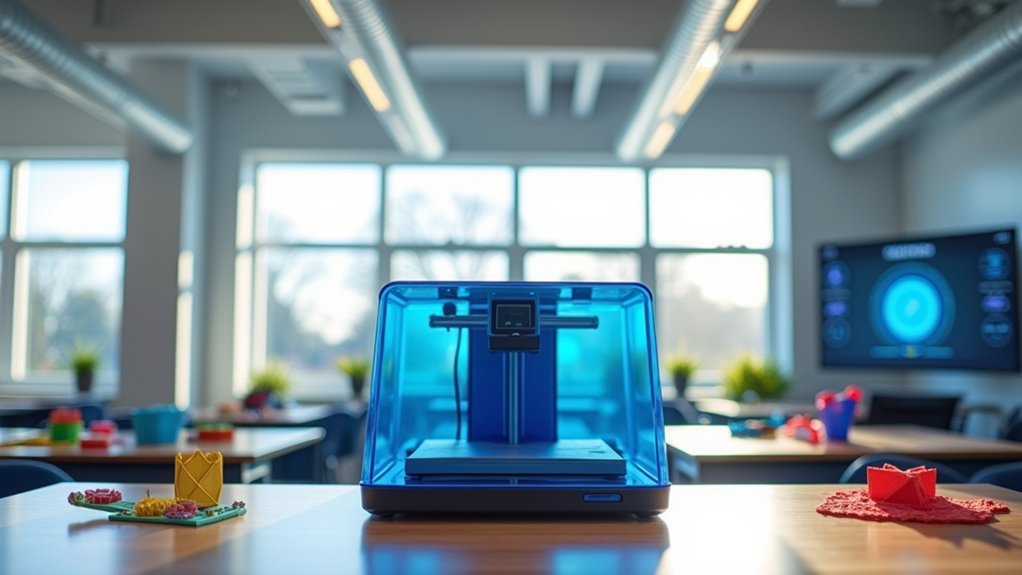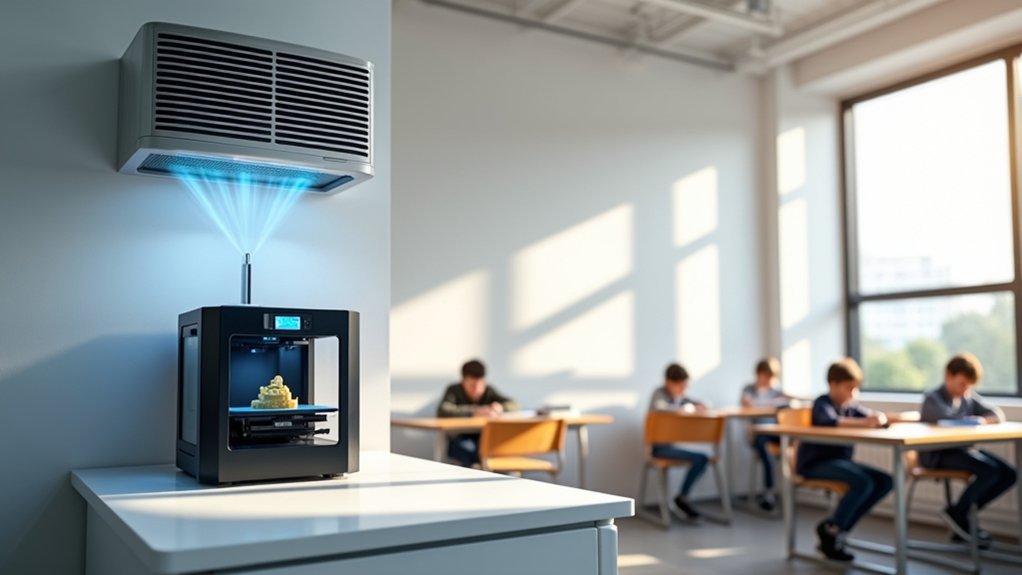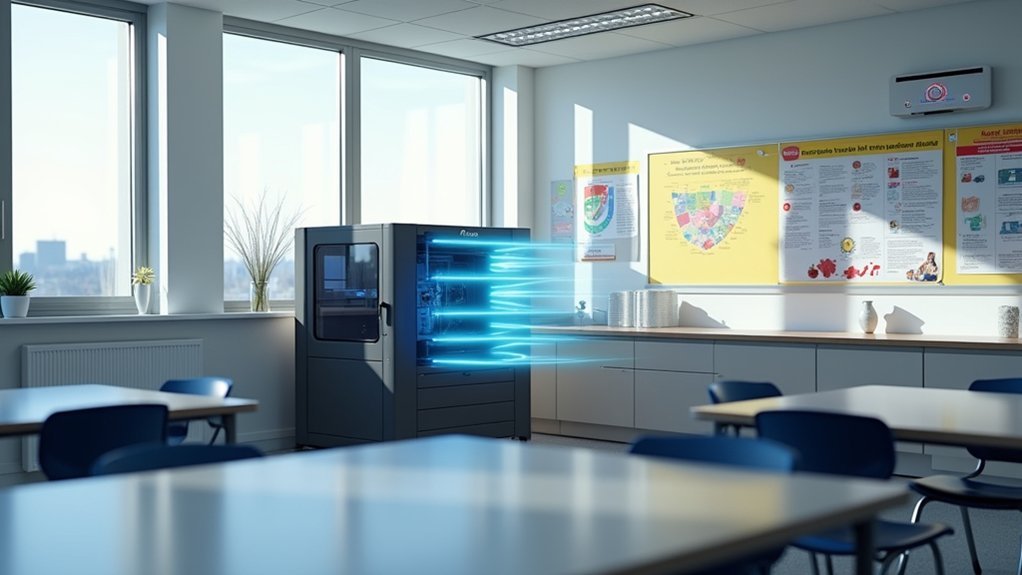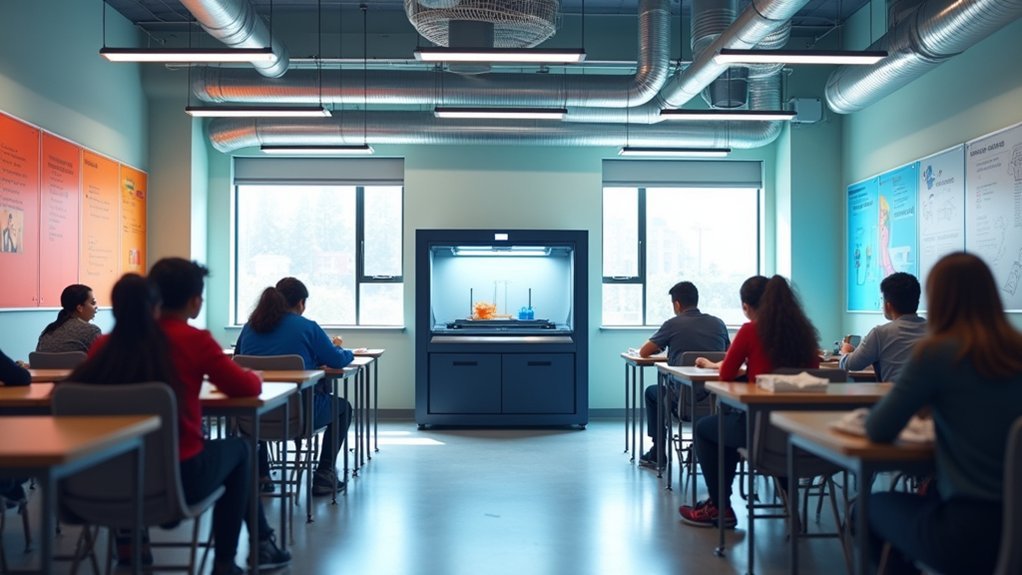You’ll need to implement ASHRAE’s recommended 4-10 air changes per hour and position local exhaust ventilation within 12 inches of your printers for 90% particle removal efficiency. Install HEPA filtration systems that capture 99.97% of particles at 0.3 microns, maintain 3-5 feet between printers and students, and establish continuous air quality monitoring for VOCs and particulate matter. Follow EPA and OSHA guidelines while ensuring regular filter maintenance and emergency protocols to protect your classroom environment and discover additional compliance requirements.
Minimum Air Exchange Rate Requirements for 3D Printing Spaces

Proper air exchange rates form the foundation of safe 3D printing environments in educational settings.
You’ll need to implement minimum air exchange rate requirements for 3D printing spaces that meet ASHRAE’s recommended 4-10 air changes per hour (ACH) for classrooms. This guarantees adequate ventilation to remove ultrafine particles and volatile organic compounds generated during printing operations.
Your ventilation system must account for the specific filament types and number of printers operating simultaneously.
NIOSH emphasizes that proper airflow markedly reduces health risks for students and staff. You should install local exhaust ventilation systems to capture contaminants at their source while maintaining classroom-wide air exchange rates.
OSHA requires regular air quality assessments to verify compliance.
Each classroom setup demands tailored ventilation solutions based on printer density and materials used.
Local Exhaust Ventilation Systems for Particle Capture
Local Exhaust Ventilation (LEV) systems capture airborne contaminants directly at 3D printers, providing targeted protection that complements your classroom’s general air exchange requirements.
You’ll need to position LEV hoods within 12 inches of emission sources to maximize their 90% removal efficiency for particulate matter and VOCs. This strategic placement guarantees proper pollutant capture before contaminants spread throughout your classroom.
Your local exhaust ventilation system requires regular maintenance and monitoring to maintain peak performance.
Check filters, inspect ductwork, and verify airflow rates consistently to meet health and safety standards.
Implementing properly functioning LEV systems helps you comply with local and federal indoor air quality guidelines while protecting students and staff from harmful 3D printing emissions during educational activities.
HEPA Filtration Standards for Classroom Air Purification

When you’re selecting air purification systems for classroom 3D printing, HEPA filtration provides essential protection by capturing 99.97% of particles at 0.3 microns or larger.
You’ll achieve significant indoor air quality improvements by implementing these systems alongside your existing ventilation infrastructure.
You should combine HEPA filtration with local exhaust ventilation systems for maximum effectiveness. This dual approach captures contaminants directly at the source while continuously cleaning ambient air throughout your classroom.
Maintenance is critical for peak performance. You’ll need to replace filters according to manufacturer schedules and monitor system efficiency regularly.
Most educational institutions require HEPA filtration as part of their thorough air quality compliance strategies.
Your HEPA system investment protects both students and staff from ultrafine particle exposure during 3D printing activities.
Ventilation Positioning Guidelines Relative to 3D Printer Placement
You’ll need to strategically position your ventilation system to maximize airflow effectiveness around 3D printers in your classroom.
The key factors you must consider are maintaining proper distance between printers and ventilation outlets while ensuring direct airflow captures emissions at their source.
Your ventilation positioning directly impacts how well you’ll remove harmful VOCs and ultrafine particles before they circulate throughout the learning environment.
Optimal Printer Placement Distance
Strategic placement of 3D printers in classrooms requires careful consideration of distance requirements that protect students while maintaining educational accessibility.
You’ll need to establish proper ventilation by maintaining specific distances between printers and classroom elements. Position your 3D printer at least 3-5 feet from occupied areas to minimize student exposure to emissions.
For ideal printer placement distance, consider these critical requirements:
- Keep printers within 2-3 feet of local exhaust ventilation systems
- Maintain 6-foot minimum distance from air intake vents
- Position near windows for enhanced natural air circulation
- Guarantee adequate space for airflow around the printer
- Create buffer zones between multiple printers if applicable
These distance guidelines work together with proper ventilation systems to create safer learning environments while preserving hands-on educational opportunities.
Airflow Direction Requirements
Proper airflow direction forms the foundation of effective 3D printer ventilation, guaranteeing harmful emissions move away from students rather than circulating throughout your classroom. Your ventilation systems must create a negative pressure environment that draws contaminated air outward while bringing fresh air inward.
| Airflow Component | Recommended Position | Purpose |
|---|---|---|
| Air Intake | Clean source location | Supplies fresh air |
| Exhaust Ventilation | Above/adjacent to printer | Captures emissions |
| Cross-Ventilation | Strategic duct alignment | Facilitates circulation |
You’ll need local exhaust ventilation positioned directly above or beside your 3D printers to capture fumes effectively. Install fans and ducts strategically to promote cross-ventilation, allowing fresh air to enter while carrying pollutants away. Regular monitoring guarantees your airflow direction remains ideal for maintaining healthy indoor air quality.
Temperature and Humidity Control Standards During Operation

When operating 3D printers in classroom environments, maintaining specific temperature and humidity ranges becomes critical for both print quality and student safety.
You’ll need to keep classroom temperatures between 68°F and 75°F (20°C to 24°C) to guarantee ideal printer operation and reduce heat-related emissions.
Proper temperature and humidity control requires these essential monitoring practices:
- Maintain humidity levels between 30% and 50% to prevent filament absorption
- Install continuous monitoring systems to track environmental conditions
- Implement localized exhaust ventilation systems for precise control
- Guarantee adequate air exchange with 15 CFM per person minimum
- Monitor VOCs and ultrafine particle buildup in poorly ventilated spaces
Effective temperature and humidity control prevents filament degradation that affects print quality and increases harmful emissions during printing operations.
Emergency Ventilation Protocols for Equipment Malfunctions
When your 3D printer malfunctions, you’ll need swift action to protect everyone in the classroom from potentially harmful emissions.
Your emergency response must include immediate equipment shutdown, rapid air purification activation, and clear evacuation procedures that get students and staff away from contaminated air zones.
You can’t afford to hesitate when equipment fails—having these protocols ready guarantees you’ll respond effectively to minimize exposure risks.
Immediate Shutdown Procedures
Three critical seconds can make the difference between a minor 3D printer hiccup and a classroom health emergency.
When you detect overheating, unusual noises, or other malfunctions, your immediate response prevents dangerous emissions from contaminating the classroom air.
Your emergency shutdown protocol must include these essential steps:
- Turn off the printer immediately using the power button
- Unplug the unit from the electrical outlet
- Activate emergency ventilation by opening windows and doors
- Turn on fans to disperse accumulated pollutants quickly
- Notify your supervisor or designated safety personnel immediately
Don’t hesitate when something seems wrong. Quick action stops harmful particle and fume release while emergency ventilation clears existing contaminants.
Regular training guarantees you’ll respond instinctively during actual emergencies.
Air Purification Systems
Multiple layers of air purification create your essential defense against dangerous emissions when 3D printers malfunction in classroom settings. You’ll need HEPA and activated carbon filters working together to capture volatile organic compounds and ultrafine particles that equipment failures release. These air purification systems require strategic placement near printers and continuous monitoring integration.
| Filter Type | Target Pollutants | Effectiveness | Maintenance Frequency | Cost Range |
|---|---|---|---|---|
| HEPA | Ultrafine particles | 99.97% | 6-12 months | $50-200 |
| Activated Carbon | VOCs, odors | 85-95% | 3-6 months | $30-150 |
| Pre-filters | Large particles | 90-95% | 1-3 months | $10-40 |
| UV-C | Pathogens | 99% | 12-18 months | $100-300 |
| Ionizers | Airborne particles | 80-90% | Annual cleaning | $75-250 |
Regular indoor air quality monitoring helps you detect system performance and adjust filtration accordingly.
Evacuation Safety Protocols
Although air purification systems provide excellent protection during normal operations, equipment malfunctions demand immediate emergency protocols to safeguard everyone in your classroom.
When 3D printer emergencies occur, you’ll need robust evacuation safety protocols that guarantee swift response and student protection.
Your emergency response plan should include:
- Immediate equipment shutdown and emergency ventilation activation
- Clear evacuation routes and procedures for excessive fumes or smoke
- Regular emergency drills featuring 3D printer malfunction scenarios
- Carbon monoxide detectors and air quality monitors for early warning
- Established communication protocols for incident reporting and personnel response
You must conduct regular drills to familiarize students with these evacuation safety protocols.
Installing proper monitoring equipment provides vital early detection, while designated personnel should know exactly how to respond to ventilation emergencies and coordinate effective evacuations.
Air Quality Monitoring Equipment and Measurement Standards
When you’re setting up 3D printing operations in your classroom, you’ll need thorough air quality monitoring equipment that tracks volatile organic compounds (VOCs), particulate matter, and environmental conditions like temperature and humidity.
Your monitoring systems should follow EPA and OSHA guidelines, which establish specific pollutant thresholds for safe indoor environments.
You’ll want real-time monitoring capabilities that provide immediate feedback when pollution levels exceed acceptable limits. This allows you to take prompt action during 3D printing sessions.
Regular calibration and maintenance of your equipment are essential for accurate measurements and regulatory compliance.
Consider integrating your air quality monitoring equipment with your ventilation system. This connection enables automatic adjustments based on real-time data, optimizing air quality throughout your 3D printing operations without manual intervention.
Ventilation Maintenance Schedules and Filter Replacement Timelines
Your air quality monitoring equipment will only perform effectively if you maintain your ventilation system properly through scheduled inspections and timely filter replacements.
Proper ventilation maintenance guarantees your classroom’s air quality remains safe during 3D printing activities.
Establish these key maintenance protocols:
- Monthly inspections – Check filters for cleanliness and proper function
- Filter replacement every 3-6 months – More frequently with heavy printer usage or elevated pollutants
- HEPA filter installation – Captures ultrafine particles and VOCs effectively
- Annual system testing – Assess airflow and efficiency against safety standards
- Maintenance documentation – Log all activities for regulatory compliance and inspection reference
You’ll need to adjust replacement schedules based on your specific usage patterns and air quality readings.
Consistent documentation helps you track performance trends and guarantees you’re meeting health regulations.
Building Code Compliance for Educational 3D Printing Facilities
You’ll need to guarantee your educational facility’s HVAC system meets specific building code requirements designed for spaces housing 3D printers.
These codes typically mandate minimum air change rates and specialized ventilation controls to manage emissions from printing operations.
You must also comply with safety code standards that address fire prevention, electrical requirements, and emergency ventilation protocols specific to 3D printing environments.
HVAC System Requirements
Since educational facilities must adhere to strict building codes when incorporating 3D printing technology, you’ll need to verify your HVAC system meets or exceeds ASHRAE’s minimum ventilation requirement of 15 CFM per person in classrooms.
Your HVAC systems must specifically address 3D printer emissions, including ultrafine particles and volatile organic compounds. To achieve ideal air quality management, implement these essential components:
- Local exhaust ventilation (LEV) systems positioned near 3D printers
- Enhanced air filtration to capture ultrafine particles
- Appropriate air exchange rates for continuous circulation
- Temperature and humidity controls for ideal printer performance
- Emergency ventilation protocols for unusual emission events
You’ll also need to establish regular maintenance schedules and conduct periodic indoor air quality assessments.
These evaluations help verify your system effectively manages emissions while maintaining compliance with safety guidelines and regulatory standards.
Safety Code Standards
When establishing 3D printing facilities in educational settings, schools must navigate a complex web of building code requirements that directly impact ventilation system design and implementation.
You’ll need to guarantee compliance with National Fire Protection Association (NFPA) standards and International Building Code (IBC) requirements to establish proper safety protocols for 3D printer operations.
Your institution must follow OSHA guidelines for air quality management, which mandate regular monitoring of air pollutants and implementation of protective measures for students and staff.
Safety assessments should evaluate fire hazards associated with printing materials while guaranteeing adequate ventilation captures harmful emissions like VOCs and ultrafine particles.
Regular maintenance and assessment of your ventilation systems are essential for ongoing compliance with safety standards and effective risk mitigation.
Integration Standards for Existing HVAC Systems With 3D Printing Equipment
Although most classrooms already have HVAC systems in place, you’ll need to upgrade these existing networks to handle the unique challenges that 3D printing equipment presents.
Existing classroom HVAC systems require significant upgrades to safely accommodate the air quality challenges posed by 3D printing technology.
Start with a thorough assessment of your current airflow and ventilation capacity to determine what modifications are necessary.
Your integration plan should include these essential components:
- Install local exhaust ventilation (LEV) to capture emissions directly at the printer source
- Upgrade filters to HEPA or activated carbon systems for removing particulates and VOCs
- Enhance airflow rates to meet increased ventilation demands
- Add monitoring systems to track air quality in real-time
- Establish maintenance schedules for filter replacement and system inspections
You must guarantee compliance with local and federal indoor air quality guidelines throughout the integration process to protect student and staff health.
Frequently Asked Questions
What Are the Ventilation Requirements for a 3D Printer?
You’ll need local exhaust ventilation systems capturing emissions at the source, plus 4-6 air changes per hour minimum. Install HEPA filter air purifiers and regularly monitor air quality after printing sessions.
Does a 3D Printer Need to Be in a Well-Ventilated Area?
Yes, you’ll need to place your 3D printer in a well-ventilated area. It emits harmful VOCs and ultrafine particles that can cause respiratory issues, so proper ventilation protects you from inhaling dangerous fumes.
What Are the Ideal Room Conditions for 3D Printing?
You’ll need temperatures between 68-77°F and humidity at 30-50%. Guarantee proper ventilation with exhaust systems, isolate from high-traffic areas, monitor air quality regularly, and use air purifiers for safety.
What Is the 45 Degree Rule for 3D Printing?
You shouldn’t print overhangs exceeding 45 degrees from vertical without supports. This rule prevents sagging and print failures by ensuring each layer has adequate material underneath for proper adhesion and structural integrity.





Leave a Reply